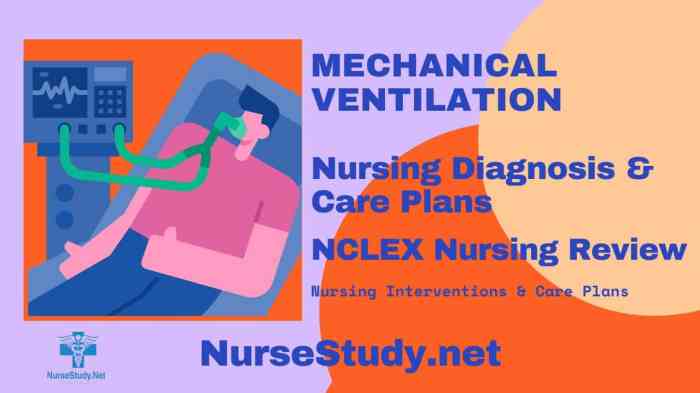Nursing care advanced airways and mechanical ventilation edapt provides a comprehensive overview of the advanced airway management and mechanical ventilation techniques employed in nursing practice. This guide delves into the intricacies of advanced airway devices, mechanical ventilators, and the nursing care required for patients undergoing these interventions.
By exploring the principles, applications, and ethical considerations surrounding these procedures, this guide empowers nurses with the knowledge and skills necessary to deliver optimal care to critically ill patients.
Throughout this guide, readers will gain a thorough understanding of the different types of advanced airway devices, including their indications, insertion techniques, and potential complications. The principles of mechanical ventilation, including ventilator settings and modes, will be подробно описано. Furthermore, the nursing care of patients on mechanical ventilation, encompassing assessments, interventions, and potential complications, will be meticulously examined.
Advanced Airway Management

Advanced airway management involves the insertion of a device into the airway to maintain or restore ventilation. It is used in situations where the patient is unable to maintain a patent airway on their own, such as during general anesthesia, cardiac arrest, or respiratory failure.
There are several types of advanced airway devices, including:
- Endotracheal tube
- Laryngeal mask airway
- Tracheostomy tube
The choice of device depends on the patient’s condition and the clinician’s experience.
Inserting an advanced airway device requires careful technique and attention to detail. The following steps are typically followed:
- Preoxygenate the patient with 100% oxygen.
- Position the patient in a sniffing position.
- Insert the device into the airway using the appropriate technique.
- Confirm placement of the device by auscultating breath sounds and checking for chest rise and fall.
- Secure the device in place.
Potential complications of advanced airway management include:
- Trauma to the airway
- Infection
- Aspiration
- Hypoxia
Mechanical Ventilation

Mechanical ventilation is a life-support technique that involves the use of a machine to assist or replace the patient’s own breathing. It is used in patients who are unable to breathe adequately on their own, such as those with severe respiratory failure, acute respiratory distress syndrome (ARDS), or other conditions that impair lung function.
The principles of mechanical ventilation involve:
- Delivering a positive pressure breath to the patient’s lungs.
- Cycling the ventilator to allow for exhalation.
- Adjusting the ventilator settings to meet the patient’s individual needs.
There are different types of mechanical ventilators, including:
- Volume-cycled ventilators
- Pressure-cycled ventilators
- Time-cycled ventilators
The choice of ventilator depends on the patient’s condition and the clinician’s experience.
The settings on a mechanical ventilator are typically adjusted to meet the patient’s individual needs. These settings include:
- Tidal volume
- Respiratory rate
- Positive end-expiratory pressure (PEEP)
- Inspiratory:expiratory ratio (I:E ratio)
Nursing Care of Patients on Mechanical Ventilation

Nurses play a vital role in the care of patients on mechanical ventilation. They are responsible for:
- Assessing the patient’s respiratory status
- Monitoring the ventilator settings
- Providing respiratory care, such as suctioning and chest physiotherapy
- Educating the patient and family about mechanical ventilation
Potential complications of mechanical ventilation include:
- Ventilator-associated pneumonia (VAP)
- Barotrauma
- Volutrauma
- Atelectasis
Ethical Considerations
Advanced airway management and mechanical ventilation are invasive procedures that can have a significant impact on the patient’s life. There are several ethical considerations that must be taken into account when making decisions about these procedures, including:
- The patient’s autonomy
- The patient’s best interests
- The potential risks and benefits of the procedures
It is important to involve the patient and their family in the decision-making process as much as possible.
Education and Training
Nurses who provide advanced airway management and mechanical ventilation must have specialized education and training. This training should include:
- Anatomy and physiology of the respiratory system
- Principles of mechanical ventilation
- Insertion and care of advanced airway devices
- Monitoring and troubleshooting ventilators
- Ethical considerations
Ongoing education and training is essential to ensure that nurses are up-to-date on the latest advances in advanced airway management and mechanical ventilation.
Research and Innovation
There is ongoing research and innovation in the field of advanced airway management and mechanical ventilation. This research is focused on developing new and improved devices and techniques to improve patient care. Some of the latest advances include:
- The development of new airway devices that are less invasive and more comfortable for patients
- The development of new ventilators that are more user-friendly and provide better patient outcomes
- The development of new monitoring techniques to detect and prevent complications of mechanical ventilation
These advances are helping to improve the care of patients on mechanical ventilation and are leading to better patient outcomes.
User Queries: Nursing Care Advanced Airways And Mechanical Ventilation Edapt
What are the different types of advanced airway devices?
Advanced airway devices include supraglottic airway devices (e.g., laryngeal mask airway, esophageal-tracheal combitube), tracheal tubes (e.g., endotracheal tube, tracheostomy tube), and jet ventilation devices.
What are the indications for mechanical ventilation?
Mechanical ventilation is indicated in patients with respiratory failure, defined as an inability to maintain adequate gas exchange or protect the airway. Common indications include acute respiratory distress syndrome, chronic obstructive pulmonary disease exacerbation, and pneumonia.
What are the nursing assessments required for patients on mechanical ventilation?
Nursing assessments for patients on mechanical ventilation include monitoring vital signs, respiratory status, ventilator settings, and oxygenation. Nurses also assess for potential complications, such as ventilator-associated pneumonia, pressure injuries, and sedation-related side effects.